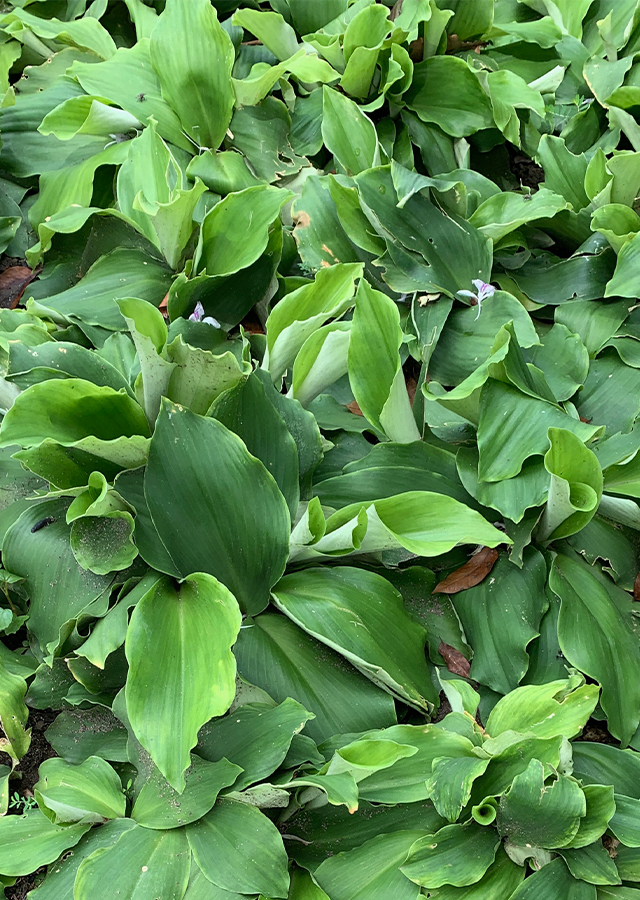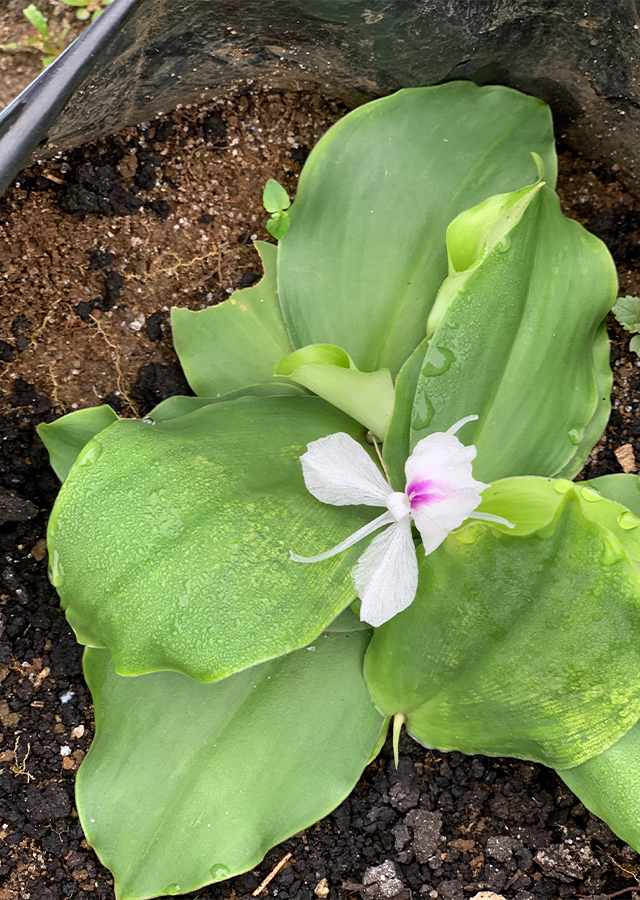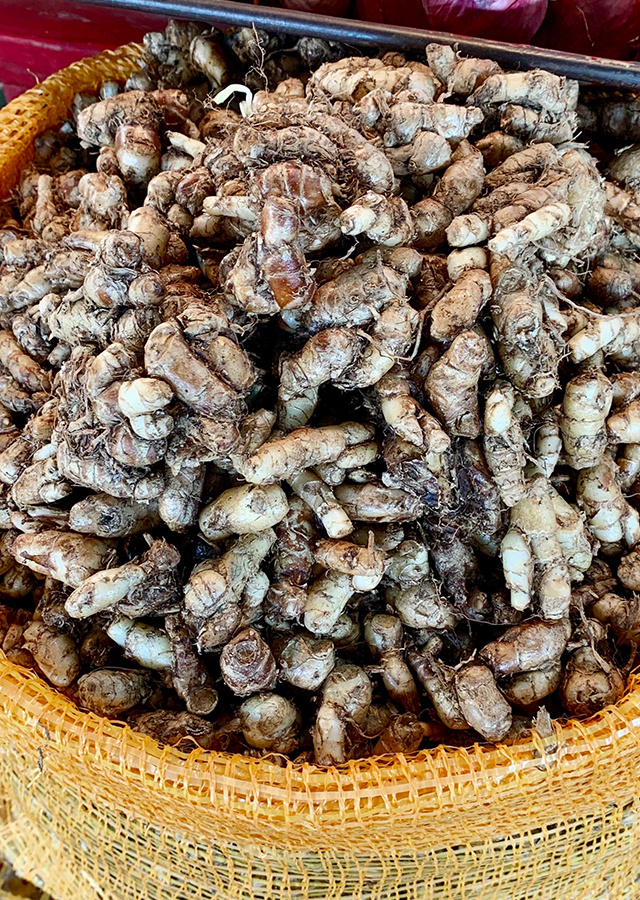Sand ginger
Kaempferia galanga L.
Zingiberaceae
Location in our garden
Principal



Synonym
Alpinia sessilis J.Koenig
Kaempferia humilis Salisb.
Kaempferia latifolia Donn ex Hornem.
Habitus
Herbaceous. A small perennial, low and stemless rhizomatous herb, growing up to 45 cm tall.
Part Used
Rhizome
Growing Requirements
Need Shade
Habitat
Forest
Overview
The plant is indigenous to India and is widely grown in E. Asia - southern China, India, Bangladesh, Myanmar, Thailand, Cambodia, Vietnam. Collected from the wild as food and medicine for local use. It is also grown as an ornamental plant and often cultivated as a spice in the tropics, especially in India, Malaya and China.
Vernacular Names
Kunsa gamon (Burmese), Sha jiang (Chinese), Chandu mula/Ekangi (India), Kenchoru (Japanese), Van hom (Laos), Kencur (Malaysia), Proh (Thai).
Agroecology
The species occurs in tropical ecological areas, having mean annual temperature in the range of 17-30 °C and a relative humidity above 75% and rainfall averaging 2,000 mm a year. It thrives best in partial shade in open forests, forest margins, and bamboo forest up to altitude of 1,000 m. This plant prefers sandy and loamy soils which are free draining and friable with pH from 5.5 to 6.5 and also drought tolerant.
Morphology
Morphology
- Rhizomes - pale yellow to yellowish green inside, cylindric, tuberous, fibrous, and aromatic.
- Leaves - usually 2-3-5, spreading low and horizontally on ground, leaf sheath is 2-3 cm long, leaf blade is green, broadly ovate to sub-orbicular, glabrous.
- Flower - inflorescences terminal emerging from between the leaves, corolla tube is 2.5 x 2 cm, lobes are white with purple marking at base.
Cultivation
Propagated by seed and division of rhizomes.
Chemical Constituents
- Phenolics, Ascorbic acid, Carotenes, Xanthophylls, Borneol, Cadinenes, Camphene, Tannins, Chloroform, Aqueos extract, Essential oil, Kaempferol.
Traditional Medicinal Uses
Medicinal Uses
- Stimulate the stomach and menstrual functions.
- Abdominal pain relief.
- Aid in the treatment of tooth decay, cough, and chest pain.
- It is used in the treatment of dyspepsia, rheumatism, gastralgia, cold, diarrhea, arthralgia, oedema, asthma, indigestion, hypertension, headache, toothache, various inflammatory diseases, diabetes mellitus, and obesity.
- It is antibacterial, has diuretic effects and increases digestion.
- The aromatic, carminative, diuretic, stimulant, and expectorant rhizomes were considered.
Traditional Uses
- To treat colds, bronchial problems, dyspepsia, and other gastric complaints, and headaches, the rhizome is used internally. To treat sore throats and coughs, it is chewed. It is used in the treatment of high blood pressure and asthma in conventional medicine. The roots are a postpartum herbal ingredient.
- Externally, for cuts, swellings, and ulcers, the rhizome is applied as a poultice and is often used to treat dandruff and rheumatic joints. It is used for sore throats as a gargle.
- The leaves are chewed to treat coughs and sore throat.
- A successful cicatrizant is a rhizome mixed with oil in the Philippines (healing by scar formation).
- In India, rhizome powder or ointment is used for cuts and bruises to reduce swelling, as well as for mumps and cancer swelling.
- In China, for indigestion, colds, stomach pain, headache, and toothache, rhizome decoction or powder is used.
- It is used for inflammatory disorders, diabetes, and obesity in Ayurveda.
- The rhizome and leaves are pounded and applied as a poultice or lotion
- The rhizome is also used to make perfumes
Part Used
Reference Sources
- Useful Tropical Plants. Kaempferia galanga L. https://tropical.theferns.info/viewtropical.php?id=Kaempferia+galanga.
- NParks. Kaempferia galaga L https://www.nparks.gov.sg/florafaunaweb/flora/2/1/2164.
- Techaprasan, J., Klinbunga, S., Ngamriabsakul, C. & Jenjittikul, T. (2010). Genetic variation of Kaempferia (Zingiberaceae) in Thailand based on chloroplast DNA (psbA-trnH and petA-psbJ) sequences Genetics and Molecular Research 9: 1957-1973.
- Preetha TS, Hemanthakumar AS and Krishnan PN. 2016. A comprehensive review of Kaempferia galanga L. (Zingiberaceae): A high sought medicinal plant in Tropical Asia. Journal of Medicinal Plants Studies. 4(3): 270-276.

